Research by: Sandeep Puri, Siddhant Puri, Rameshwar Dubey, & Jayanthi Ranjan
Abstract
In November 2021, Procter & Gamble Company (P&G)’s announcement regarding the recall of more than a dozen of its Old Spice and Secret aerosol deodorants and sprays over elevated levels of benzene threatened to damage their brand value.[1] P&G’s recall decision came shortly after Valisure, a private pharmaceutical company, filed a US Food and Drug Administration (FDA) citizen petition. Valisure had detected benzene levels nine times higher than the permissible two-parts-per-million FDA limit in 54 percent of the 108 batches of antiperspirant body sprays they had tested from thirty brands. Old Spice body sprays showed the most contamination.[2]
Since brand recalls come at a cost to both the bottom line and brand value, a company must manage the recall to minimize the effect on the brand and the company’s reputation. The case describes P&G’s recall process and the impact of a product recall on a company that has brands such as Old Spice and Secret with a huge global presence and appeal. Moreover, with P&G’s deodorant sales in 2021 growing by only 4 percent over 2020 in the US, the company needs to consider the possibility of a loss in consumer confidence in its deodorant brands after the product recalls.[3] This leaves room not only for competitors to take advantage of the gaps in consumer trust but also for a slump in the company’s market share, brand image, and internal and external stakeholders’ trust. As P&G progress with their recall, what can they do to sustain trust and confidence among their consumers and use the recall as an opportunity to solidify their brand image and superiority proposition and prevent an irreversible loss in their profits.
Learning Objectives
The case allows students to explore various marketing-related issues regarding recalls of popular products. In addition, students will gain insight into managing product recall situations. After working through the case and assignment questions, students will be able to:
- identify the causes and consequences of product recalls and how they might be avoided;
- examine the role of marketing communications in product recalls, especially direct marketing and public relations; and
- identify the factors in product recall effectiveness and success.
To cite this case: Puri, S., Puri, S., Dubey, R., & Ranjan, J. (2023). Procter and Gamble: Recall of Old Spice Deodorants. Ivey ID: W30794. London, Canada: Ivey Publishing.
To access this case: https://www.iveypublishing.ca/s/product/procter-gamble-recall-of-old-spice-deodorants/01t5c00000CcuNmAAJ
[1] Jackie Wattles, “Some Old Spice and Secret Deodorants Recalled after Cancer-Causing Chemical is Detected,” CNN Business, November 26, 2021, accessed on January 18, 2022, https://edition.cnn.com/2021/11/26/business/old-spice-secret-deodorant-recall-benzene/index.html.
[2] Jessica Rendall, “Some Old Spice, Secret aerosol sprays recalled over benzene contamination,” CNET, November 24, 2021, accessed on June 18, 2022, https://www.cnet.com/health/personal-care/some-old-spice-secret-aerosol-sprays-recalled-over-benzene-contamination/.
[3] Dominique Petruzzi, “Sales Growth of the Leading Deodorant Vendors in the United States in 2021,” Statista, May 3, 2022, accessed on June 18, 2022, https://www.statista.com/statistics/194806/us-sales-growth-of-deodorant-vendors-in-2013/.





